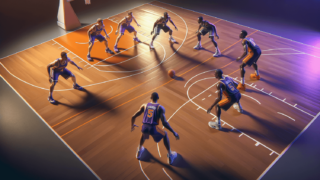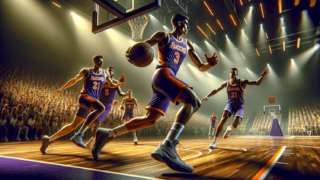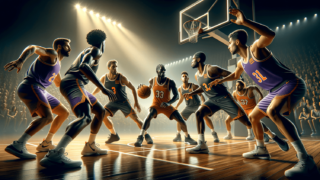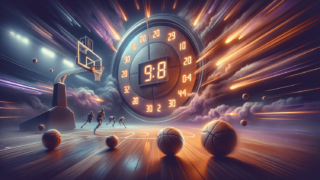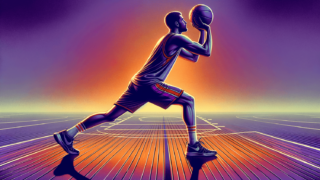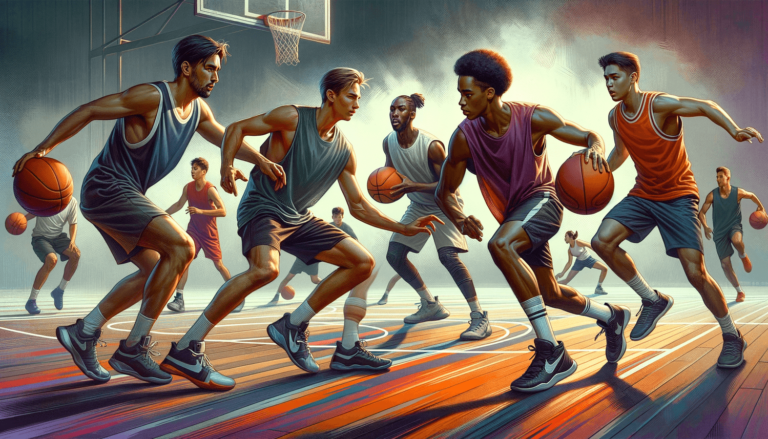
How to Improve Your Ball Handling Skills in Basketball?
Written by: Basketball Universe
Last updated:

Welcome to the exciting world of basketball! In this blog post, we’ll be diving deep into one of the most essential skills every aspiring hooper should master: ball handling. Whether you’re a seasoned player or just starting your journey on the hardwood, improving your ball handling skills can elevate your game to new heights. With a perfect balance of fun and professionalism, we will provide you with tips and techniques designed to boost your confidence and enhance your ability to dribble, pass, and control the ball like a pro. So, if you’re ready to unlock your full potential on the court, sit back, relax, and let’s explore the art of ball handling together!
How to Improve Your Ball Handling Skills in Basketball?
To improve your ball handling skills in basketball, focus on mastering the fundamentals and incorporating specific drills into your routine. Start by developing proper posture, hand positioning, and finger control. Next, practice various dribbling moves, such as crossovers, in-and-out dribbles, and hesitation moves. Incorporate both speed and agility drills, and use two-ball dribbling exercises to enhance coordination. Finally, strengthen your weak hand and engage in real-game situations to build your confidence and skills under pressure.
Mastering the Fundamentals
Before diving into the depths of ball handling techniques, it’s crucial to grasp the fundamentals of good posture, hand positioning, and finger control. This solid foundation will act as a springboard for further improvement.
Posture and Body Position
Good posture and body positioning are crucial to maintaining balance and control while handling the basketball. Maintain a low, athletic stance with your knees bent and back straight. Stay on the balls of your feet, ready to react at any moment. Keep your eyes up and focused on the court, scanning for opportunities to make a killer play.
Hand Positioning and Finger Control
Effective hand positioning allows you to maximize control of the basketball. When dribbling, spread your fingers wide and use your fingertips, not your palms, to manipulate the ball. This gives you the dexterity and precision needed to execute quick moves and change direction with ease. Aim to keep your hands and fingers responsive, like a skilled pianist tickling the ivories of a grand piano.
Powerful Dribbling Moves
Having a diverse repertoire of dribbling moves in your arsenal dramatically increases your ability to deceive defenders and create opportunities. Let’s explore some of the most effective and popular dribbling moves to add to your toolkit.
Crossovers
A crossover is a fundamental and versatile dribbling move that quickly changes the ball from one hand to the other in front of the body. This explosive motion can leave defenders off-balance, paving the way for a clear drive to the basket or an uncontested shot. Practice your crossover in both directions, incorporating a low and controlled dribble to minimize the chance of losing possession.
In-and-Out Dribbles
The in-and-out dribble is a subtle yet powerful move that involves faking in one direction before exploding the opposite way. The quick, fluid motion is achieved by rolling the basketball from the inside to outside of the hand that is dribbling. Mastering this move can deceive defenders and create lanes for penetrative drives or open shots.
Hesitation Moves
Hesitation moves, also known as stutter steps, involve momentarily slowing down or pausing during a dribble to cause defenders to relax, only to speed up again and leave them in your wake. There are countless variations of hesitation moves, but the key principle remains the same: lull your defender into a false sense of security and then pounce on their indecision.
Speed and Agility Drills
Not only do superior speed and agility contribute to overall athleticism, but they also enhance ball handling prowess. Incorporating these drills into your training will pay dividends when it comes to outmaneuvering opponents and evading pesky defenders on the basketball court.
Speed Dribbling Drills
Speed dribbling drills challenge players to move the basketball up and down the court as quickly as possible while maintaining control. To maximize the benefits of speed dribbling, alternate between a low, controlled dribble and a higher, faster dribble while maintaining a strong sprint. Shoot for consistency and gradually increase the pace as you grow more confident.
Agility Ladder Drills
Agility ladder drills, using a patterned or channelled ladder design, help improve footwork, hand-eye coordination, and explosiveness in basketball. Practice dribbling through the ladder while executing different footwork patterns, such as single-leg or two-leg hops, forward and backward runs, or lateral shuffles. The goal is to develop quick and precise steps, strengthening your foundation for improved ball handling under pressure.
Two-Ball Dribbling Exercises
Two-ball dribbling exercises might seem unorthodox, but they offer incredible value in building coordination, rhythm, and ambidexterity. These challenges push the limits and require focused practice to conquer.
Simultaneous Dribbling
Start by dribbling two basketballs at the same time, aiming to keep them at the same height and speed. This exercise enhances focus and coordination, making single-ball dribbling feel comparatively effortless. Gradually increase the speed and challenge yourself to maintain consistency and control.
Alternating Dribbling
As the name suggests, this exercise involves dribbling two basketballs in an alternating pattern. Begin with one ball hitting the ground, followed immediately by the other. Mastering the timing and rhythm of alternating dribbling requires practice but offers a significant boost to hand-eye coordination.
Strengthen Your Weak Hand
Developing strength and skill in your non-dominant hand is a game-changer, giving a genuine edge over your competition. Invest time and effort into fortifying your weak hand, and observe your ball handling skills skyrocket.
Weak Hand Dribbling Drills
Incorporate weak hand-specific dribbling exercises into your practice routine. Focus on dribbling low and under control around various obstacles, such as cones, chairs, or other players. Implement different dribbling moves, exploring both stationary and dynamic drills in diverse directions, to build proficiency with your non-dominant hand.
Two-Handed Drills
Push your weak hand skills further by participating in two-handed drills, emphasizing the use of your non-dominant hand. Examples of two-handed drills include the two-ball variation discussed earlier and the classic figure-eight drill, threading the ball between your legs in a figure-eight pattern using both hands. Executing challenging, two-handed exercises bolsters comfort and competence when handling the basketball with your weaker arm.
Embrace Real-Game Situations
Putting your hard-earned ball handling skills to the test during real-game situations is the ultimate measure of your progress. Apply these tactics to build confidence and competence under pressure.
One-On-One Drills
One-on-one drills directly confront the challenges involved in breaking down defenders. With an opponent actively trying to impede your progress, practice your new and improved dribbling moves to unlock their defensive stance. Analyze the success of your attempts and modify approaches as needed, building resilience and resourcefulness on the court.
Full-Court Scrimmages
Full-court scrimmages, often considered the most enjoyable aspect of basketball, offer several benefits to ball handlers. The fast-paced, competitive environment challenges players to apply their skills under pressure and teaches decision-making abilities vital to succeeding on the hardwood. Embrace each scrimmage as an opportunity to practice your improved ball handling skills in a live-action setting.
Remember, the road to basketball excellence is paved with consistent practice, dedication, and effort. As you incorporate these techniques and exercises into your training regiment, trust the process and enjoy watching your ball handling skills soar to new heights. The possibilites are limitless!
Boost Your Confidence On the Court
To truly shine as a ball handler, building confidence in your abilities is key. Confidence allows you to remain calm and composed under pressure, making better decisions and executing flawless moves during tense moments in a game.
Visualize Success
Visualization is a powerful mental tool used by elite athletes to prepare for peak performance. Spend time each day envisioning yourself successfully executing dribbling moves, breaking down defenders, and dominating the court. This mental exercise reinforces neural pathways, promoting self-belief and an expectation of success.
Celebrate Progress and Achievements
Acknowledging your hard work and celebrating your accomplishments is essential for maintaining motivation and self-confidence. Take pride in the strides you’ve made, and set realistic goals for continued improvement. In moments of doubt, remind yourself of the challenges you’ve conquered and the progress you’ve made on your journey to becoming a skilled ball handler.
Enhance Your Physical Fitness
Physical fitness is paramount to maximizing your potential as a ball handler. Developing strength, endurance, and flexibility can help you excel on the basketball court, turning you into a force to be reckoned with.
Strength Training
Focusing on core, upper body, and lower body strength can elevate your basketball game to a new level. Stronger muscles contribute to increased power and stability, allowing you to maintain control of the ball under physical duress. Incorporate strength training exercises like squats, lunges, push-ups, and core workouts into your fitness routine.
Cardiovascular Endurance
Regular cardiovascular exercise improves overall endurance, allowing ball handlers to maintain high levels of energy and speed throughout an entire game. Harness the benefits of running, biking, or swimming to increase your stamina, making sure to include both steady-state and high-intensity interval training (HIIT) workouts in your regimen.
Flexibility and Balance
Enhancing flexibility and balance can positively impact your agility and overall movement on the court. Incorporate stretching exercises and activities like yoga or Pilates into your routine to improve flexibility and strengthen the stabilizing muscles involved in maintaining balance during on-court basketball action.
Study the Greats
Looking to the game’s greatest ball handlers provides invaluable insight and inspiration for aspiring players. Study footage of iconic dribblers such as Magic Johnson, Allen Iverson, Stephen Curry, or Kyrie Irving, noting their style, technique, and decision making. Try to emulate your favorite players’ key moves on the court, adding your personal flair to create a unique ball handling style.
As you dedicate yourself to improving your basketball ball handling skills using the concepts outlined in this post, remember that consistency and patience are vital. With regular practice and an unwavering commitment to growth, you’ll soon dazzle defenders and lead your team to victory.
Frequently Asked Questions
If you’re seeking additional clarity on improving your basketball ball handling skills, the following FAQ section addresses ten common questions related to the topic. Use these answers as a valuable resource and a complement to the tips and techniques provided in this blog post.
1. How long does it take to improve my ball handling skills?
Improvement varies from person to person and depends on your current skill level, dedication to practice, and overall athletic ability. With consistent effort and focused training, you can expect to see noticeable improvements within a few weeks to a couple of months. However, continuous improvement is key, and the best players never stop refining their skills.
2. How often should I practice ball handling?
For optimal results, aim to practice ball handling at least three to five times per week. This frequency allows for consistent training and reinforcement of good habits while providing enough rest to prevent burnout and overtraining.
3. How can I practice ball handling at home?
You can practice a variety of stationary dribbling drills, such as dribbling in place, figure-eight drills, and two-ball dribbling exercises, to improve your ball handling skills at home. Depending on your space and available equipment, you can also incorporate agility and strength training exercises that complement your ball handling practice.
4. Can I improve my ball handling skills without a basketball?
While using a basketball is ideal, you can still work on certain aspects of ball handling without one. Focus on improving strength, balance, and dexterity by using household items as makeshift weights, performing bodyweight exercises, or engaging in activities like yoga and Pilates.
5. How important is using my non-dominant hand?
Developing your non-dominant hand is crucial in becoming a versatile and unpredictable ball handler. It allows for greater control and coordination on both sides of the court, making it difficult for defenders to anticipate your moves and increasing your overall effectiveness on the basketball court.
6. What dribbling techniques are best for beginners?
Beginners should start with mastering the basic dribble using their fingertips and practicing dribbling while walking, running, and changing direction. Incorporate foundational moves such as crossovers, in-and-out dribbles, and hesitation moves to build a solid foundation for more advanced techniques later on.
7. How can I prevent turnovers while practicing ball handling?
To minimize turnovers, focus on proper hand positioning, finger control, and maintaining a low dribble. Develop situational awareness by keeping your eyes up, scanning the court, and anticipating the movements of defenders. Regular practice in real-game situations also helps develop decision-making skills to avoid costly mistakes.
8. How does improving my ball handling skills benefit my overall basketball game?
Becoming a proficient ball handler allows you to control the pace of the game, break down defenses, and create scoring opportunities for both yourself and your teammates. It also contributes to better decision-making, increased confidence, and more effective playmaking abilities.
9. Can I practice ball handling skills alone?
Yes, many ball handling exercises can be performed independently, such as dribbling drills, figure-eight drills, and agility training exercises. However, incorporating one-on-one drills, full-court scrimmages, or team-based practice is essential to challenge yourself and develop your skills in real-game situations.
10. How do I know if my ball handling skills are improving?
Measure your progress by observing improvements in control, consistency, and speed during practice and real-game situations. Track your performance during drills and scrimmages, examine your decision-making in pressured situations, and take note of your ability to execute advanced dribbling moves with increased confidence and finesse.
Featured Posts
- No pillar pages found.

